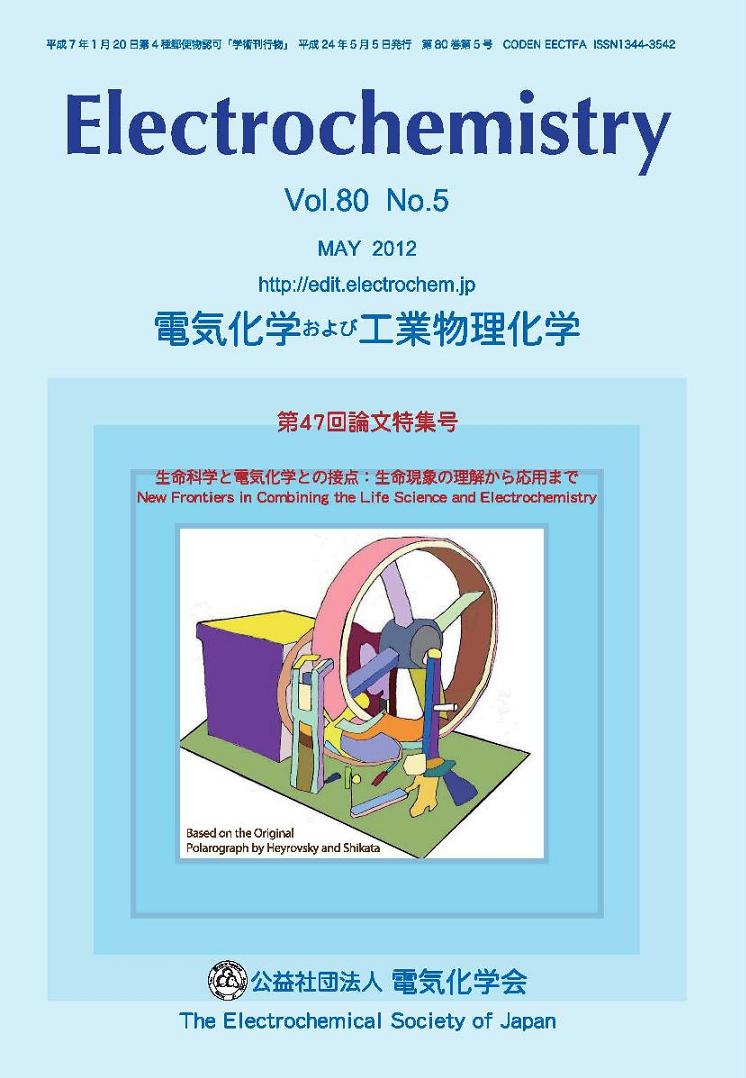Volume 80, Issue 5
Displaying 1-27 of 27 articles from this issue
- |<
- <
- 1
- >
- >|
New Frontiers in Combining the Life Sciences and Electrochemistry
Visions
-
2012 Volume 80 Issue 5 Pages 291
Published: May 05, 2012
Released on J-STAGE: May 05, 2012
Download PDF (263K) -
2012 Volume 80 Issue 5 Pages 292
Published: May 05, 2012
Released on J-STAGE: May 05, 2012
Download PDF (207K)
Headline
-
2012 Volume 80 Issue 5 Pages 293-298
Published: May 05, 2012
Released on J-STAGE: May 05, 2012
Download PDF (1397K)
Communications
-
2012 Volume 80 Issue 5 Pages 299-301
Published: May 05, 2012
Released on J-STAGE: May 05, 2012
Download PDF (980K) -
2012 Volume 80 Issue 5 Pages 302-304
Published: May 05, 2012
Released on J-STAGE: May 05, 2012
Download PDF (765K) -
2012 Volume 80 Issue 5 Pages 305-307
Published: May 05, 2012
Released on J-STAGE: May 05, 2012
Download PDF (865K) -
2012 Volume 80 Issue 5 Pages 308-311
Published: May 05, 2012
Released on J-STAGE: May 05, 2012
Download PDF (2134K) -
2012 Volume 80 Issue 5 Pages 312-314
Published: May 05, 2012
Released on J-STAGE: May 05, 2012
Download PDF (625K) -
2012 Volume 80 Issue 5 Pages 315-317
Published: May 05, 2012
Released on J-STAGE: May 05, 2012
Download PDF (399K) -
2012 Volume 80 Issue 5 Pages 318-320
Published: May 05, 2012
Released on J-STAGE: May 05, 2012
Download PDF (1274K) -
2012 Volume 80 Issue 5 Pages 321-323
Published: May 05, 2012
Released on J-STAGE: May 05, 2012
Download PDF (688K) -
2012 Volume 80 Issue 5 Pages 324-326
Published: May 05, 2012
Released on J-STAGE: May 05, 2012
Download PDF (528K) -
2012 Volume 80 Issue 5 Pages 327-329
Published: May 05, 2012
Released on J-STAGE: May 05, 2012
Download PDF (400K) -
2012 Volume 80 Issue 5 Pages 330-333
Published: May 05, 2012
Released on J-STAGE: May 05, 2012
Download PDF (681K) -
2012 Volume 80 Issue 5 Pages 334-336
Published: May 05, 2012
Released on J-STAGE: May 05, 2012
Download PDF (348K)
Articles
-
2012 Volume 80 Issue 5 Pages 337-339
Published: May 05, 2012
Released on J-STAGE: May 05, 2012
Download PDF (134K) -
Determination of Ammonia in Exhaled Breath by Flow Injection Analysis with Electrochemical Detection2012 Volume 80 Issue 5 Pages 340-344
Published: May 05, 2012
Released on J-STAGE: May 05, 2012
Download PDF (580K) -
2012 Volume 80 Issue 5 Pages 345-347
Published: May 05, 2012
Released on J-STAGE: May 05, 2012
Download PDF (281K) -
2012 Volume 80 Issue 5 Pages 348-352
Published: May 05, 2012
Released on J-STAGE: May 05, 2012
Download PDF (1059K) -
2012 Volume 80 Issue 5 Pages 353-357
Published: May 05, 2012
Released on J-STAGE: May 05, 2012
Download PDF (678K) -
2012 Volume 80 Issue 5 Pages 358-362
Published: May 05, 2012
Released on J-STAGE: May 05, 2012
Download PDF (1679K) -
2012 Volume 80 Issue 5 Pages 363-366
Published: May 05, 2012
Released on J-STAGE: May 05, 2012
Download PDF (1550K) -
2012 Volume 80 Issue 5 Pages 367-370
Published: May 05, 2012
Released on J-STAGE: May 05, 2012
Download PDF (659K) -
Nitrous Oxide Sensing using Oxygen-Insensitive Direct-Electron-Transfer-Type Nitrous Oxide Reductase2012 Volume 80 Issue 5 Pages 371-374
Published: May 05, 2012
Released on J-STAGE: May 05, 2012
Download PDF (610K)
Technological Report
-
2012 Volume 80 Issue 5 Pages 375-378
Published: May 05, 2012
Released on J-STAGE: May 05, 2012
Download PDF (659K)
-
2012 Volume 80 Issue 5 Pages 379-386
Published: May 05, 2012
Released on J-STAGE: May 05, 2012
Download PDF (843K) -
2012 Volume 80 Issue 5 Pages 388
Published: May 05, 2012
Released on J-STAGE: December 27, 2023
Download PDF (387K)
- |<
- <
- 1
- >
- >|
